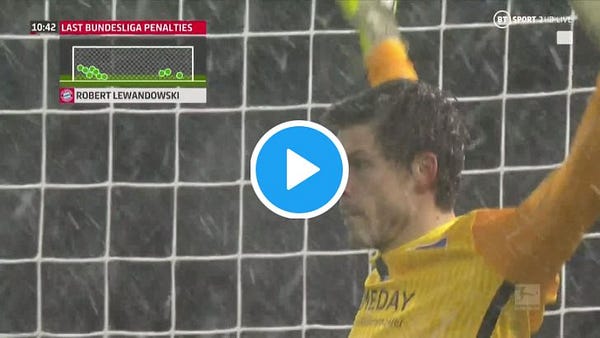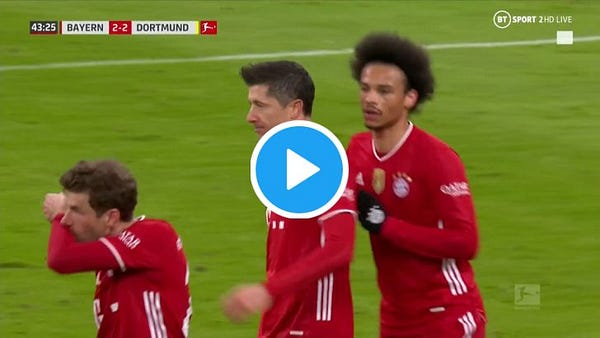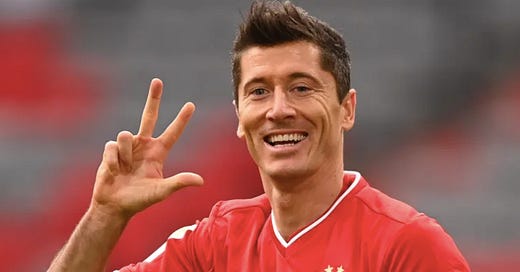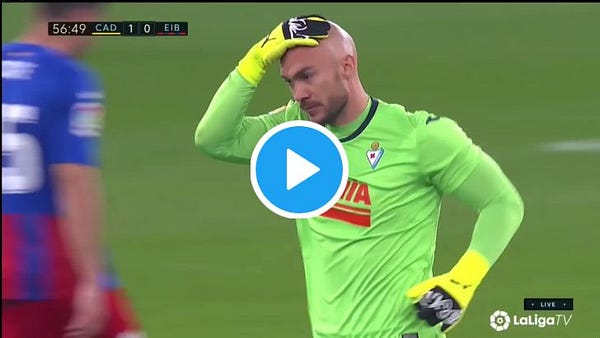It was never in doubt, was it? When Robert Lewandowski stood over his penalty in Saturday’s 4-2 Der Klassiker win over Borussia Dortmund, he looked supremely confident. He had been waiting for this moment for four weeks and two days – ever since his last penalty, against Hertha Berlin, which was saved.
That miss ended a run of 17 consecutive scored penalties. Lewandowski’s conversion rate in all competitions for Bayern is now 40 out of 44, a rate of 91 per cent. Well above average (78 per cent). So of course it was likely he would score against Dortmund. But that penalty does not tell the whole story. The story of Lewandowski and penalties is a bit like the player himself; a search for constant improvement, alongside the sometime glimpse of perfection. This is how the world’s best striker has evolved his technique to become a penalty killer.
Photo: Getty Images
The Bundesliga.com website has charted parts of Lewandowski’s penalty journey with this video, and I have used that source for some of the stats and pics in this piece.
Early days in Poland:
Lewandowski had his break-out season in 2009, when he scored 20 goals for Lech Poznan. He scored 41 goals in two seasons for the Polish club, and not a single penalty among them (just to check, I recommend this fun video showing every Lech goal he scored). As The Guardian’s Marcus Christenson notes in this excellent piece, when Lewandowski first arrives in Germany, ‘he already appears to be the complete striker’.
Borussia Dortmund:
It takes a while for Lewandowski to get on penalty duties after he moves to Dortmund. In his first season, Nuri Sahin is first-choice; in his second season, Mats Hummels and Jakub Blaszczykowski take penalties. It’s only in his third season that Lewandowski scores his first penalty in the Bundesliga: in November 2012 against Greuther Furth with a classic GK-Independent strike. He accelerates during the run-up, reaching the ball at 22km/hr, and smashes the ball high to his natural at a speed of 103km/hr. It’s unsaveable!
Photo: Bundesliga.com
His next penalty is in the 4-1 win over Real Madrid, that memorable Champions League tie in which he scores all four goals. Again, he smashes the ball using GK-Independent. A fortnight later, using the same technique, he’s up against Manuel Neuer and Bayern Munich. He sticks with GK-Independent, this time to his non-natural side. Lewy focuses only on the ball during his approach, which is at 20km/hr, and the ball travels at 106km/hr. Neuer goes the right way, but the ball is too far from the corner of the goal, and he saves it. How does Lewy respond? He sticks to the same strategy (for now) and scores his next four penalties for Dortmund.
Bayern Munich:
It seems hard to believe now, but Lewy misses his first penalty at Bayern Munich. It’s in a German Cup tie against Preuben Munster (his second game for the club), and he is off penalty duties for eight months. Thomas Muller (six penalty goals) and Arjen Robben (three) are selected.
In May 2015, on the final day of the season, he takes another penalty, still GK-Independent, and scores against Mainz. Muller, Robben and Arturo Vidal all take penalties before him the following season. It is only in May 2016 – three years after that Neuer save - that he debuts his new technique against Ingolstadt goalkeeper Ramazan Ozcan. He scores, and that penalty kick-starts an incredible run of converted penalties for club and country. From that point on, he is Bayern’s first-choice penalty-taker.
Altogether, he scores 29 penalties in a row, most of them with the new technique. Rather than accelerating towards the ball, he now slows down and looks at the goalkeeper. One stutter on his penultimate step before reaching the ball is the moment the goalkeeper shows his intention; that allows Lewandowski to roll the ball into the opposite corner. This example below has the speed of his approach down to just 8km/hr.
Photo: Bundesliga.com
Polish newspaper Weszlo reports that goalkeepers facing Lewandowski dive the correct way only three times out of 27 with this methodology. No wonder he keeps scoring! No-one can stop him - apart from himself. Sure enough, the run ends in March 2018, after his penalty hits the post against Schalke (he scored in a penalty in the same game, a 6-0 win). The run is over.
So Lewandowski goes away and changes his strategy again. He still doesn’t accelerate as he used to. And he still likes to stutter on his approach to the ball. There are two new elements: one, a triple short-step mid-run-up, which doesn’t slow down the approach. And rather than keeping his eyes fully on the goalkeeper before striking the ball, now he does something slightly different. After his stutter, he looks back down at the ball as he strikes it. The Bundesliga calculated that Lewy gives himself 0.4 seconds from looking at the goalkeeper to returning his line of sight to the ball, so he can strike the ball as cleanly as possible.
Photo: Bundesliga.com
Once he has spotted the goalkeeper shifting his weight, with a lean of the shoulder or a raised heel, he looks down and strikes. If the goalkeeper waits it out, it’s too late for him to dive and reach the shot. This technique is still mainly GK-Dependent, but with the slight twist of looking at the ball on impact.
His miss against Hertha:
So where does it go wrong against Hertha Berlin? Well, it is ten minutes into the game and it is snowing. Not perfect conditions. The score is 0-0. Lewandowski takes his normal approach. A wait after the whistle. Two skips to the left to widen the angle of the run-up. A run towards the spot. The triple short-step. By now, he has perfected this: looking up, the stutter, and looking down to roll the ball home. He’s done it seventeen times in a row! But this time, something strange happens.


The triple short-step as part of his run-up is slower than usual, and Lewy needs to get back into his run before his stutter. As he looks at the ball, Jarstein has not yet moved. He’s given no tell. So Lewy goes to the side he feels more comfortable – his natural side. The graphic of his previous penalties may have given Jarstein a clue, so that’s where he dives.
If Lewy hits the penalty sweetly, the ball evades the dive and ends up in the back of the net, just like usual. Except this time, the penalty is not struck right in the corner. It’s within Jarstein’s reach and he pushes the kick away. (It’s worth pointing out that this is his first save in 13 penalties, so he’s hardly a specialist.)
I think the conditions played a part, as did Lewandowski’s approach. His triple short-step lacked its normal fluency and the final shot was not as true as he would have liked. Those three factors combined to help Jarstein make the save.
The penalty against Dortmund:
We did not see a new technique from Lewy for the Dortmund penalty - just a better-executed version of the one that has worked for him so often before. It had all the hallmarks: perfect run-up (with the triple short-step), the stutter, the look, the roll into the favoured corner. So after one slight wobble, it’s back to business as usual. Wunderbar!


Where does this leave Lewandowski in the list of Bundesliga penalty-kickers? He has scored the most penalties in the Bundesliga over the last 15 seasons, but his conversion record is bettered, for now, by Max Kruse (formerly of Gladbach and Bremen and now at Union Berlin) and Andrej Kramaric (Hoffenheim).
BUNDESLIGA PENALTY RECORD 2005-PRESENT (from Opta):
1.Max Kruse: 18 scored /19 taken at 95 per cent conversion rate
2.Andrej Kramaric: 20/22 at 91 per cent
3.Robert Lewandowski: 33/37 at 89 per cent
4.Sejad Salihovic: 29/33 at 88 per cent
5.Vedad Ibisevic: 18/21 at 86 per cent
6.Paul Verhaegh: 18/22 at 82 per cent
Let’s leave the great striker to have the final word:
PEN PALS:
Penalty hero of the week is Ann-Katrin Berger, goalkeeper for Chelsea women. She saved two penalties – one to her right, the other to her left – in Chelsea’s 2-0 Champions League win over Atletico Madrid. Considering Chelsea were down to ten players after an early sending-off, that’s a superb result in the competition they really want to win this season.
Thanks for the feedback on last week’s piece on two-touch penalties. My friend Hassanin told me about a two-touch penalty in a Baghdad league game between Al-Quwa Al-Jawiya and Al-Maslaha in 1963. Sadly, there is no footage, just the confirmation from Samad Assad, who played in the game. And my old (but actually very young) friend Phil was curious about the encroachment law on penalties as Henry Martin’s body was leaning over the line when his team-mate Sebastian Cordova first touched the ball. It turns out IFAB changed the law this season so pre-penalty encroachment only counts if the player’s foot is touching down over the line. So now we know!
Poor old Marko Dmitrovic. Eibar’s hero in January for stepping up to score from the spot and solve their penalty problems, the Serbian goalkeeper was the villain in Saturday’s defeat at Cadiz, as his penalty was saved. The kick went out for a corner, so sadly there was no danger of a quick counter-attack!
Please share any penalty thoughts or further questions to me either by commenting below or at @benlyt.
If you enjoyed this post, please spread the word about Twelve Yards and share this with your network. And if you’re new, you can see recent pieces including: who really invented the two-touch penalty (and Robert Pires relives his trauma) why it’s better to aim high than low, the great Ederson penalty debate, an interview with Antonin Panenka, how to define a true Panenka, how to end Antoine Griezmann’s run of five missed penalties in a row, penalty records in empty stadia, and Barcelona’s first shoot-out win in 23 years. Thank you!
Ben Lyttleton is the author of Twelve Yards: The Art and Psychology of the Perfect Penalty















